Features of Cross-Correlation Analysis in a Data-Driven Approach for Structural Damage Assessment
Abstract
1. Introduction
2. Damage Assessment Elements
2.1. Hardware and Experimental Setup
2.1.1. Pipe Section
2.1.2. Aircraft Wing Structure
2.1.3. A Blade of a Commercial Aircraft Turbine
2.2. Statistical Processing
2.2.1. Preprocessing through Cross-Correlation Analysis
2.2.2. Principal Component Analysis: Baseline Model Building
- Level 1—Data Organization: In this part, cross-correlated signals of each PZT sensor belonging to several repetitions of the undamaged structural state are organized in an unfolded data matrix (Figure 8).The collected data are arranged in an matrix, which contains information from m sensors and n experimental trials. K is the number of time samples recorded in the i-th experiment repetition. Thus, each row vector represents measurements from all sensors (experiment trial), and each column vector represents measurements from one sensor in the whole set of experiment trials at a specific time instant.
- Level 2—Data Normalization: The undamaged cross-correlated baseline matrix is normalized in order to avoid scaling and bias issues and to reduce the influence of different sources of variability. In this work, normalization is computed by means of group scaling (GS), where each data point from the undamaged cross-correlated baseline matrix (X) is scaled by considering changes between sensors and the nature of the data by estimating the standard deviation for each block of piezo measurements [27]. Thus, a normalized data matrix is obtained by standardizing X using the mean of each time sample for every experiment and the standard deviation of each sensor sample vector, where each element is determined by Equation (5).where is the standard deviation per PZT sensor and is the mean value at a specific time instant of undamaged cross-correlated baseline matrix X.
- Level 3—Optimal Basis Representation: The next step is to find a set of r basis vectors (P) that satisfies the extreme value problem established by Equation (6), in order to minimize the fitness function [28].The basis vector P can be estimated by computing the singular value decomposition of the covariance matrix established by Equation (7), which can be solved by using NIPALS, POD, or QR procedures [29].where M is the number of trial records used to estimate the covariance matrix, and the respective eigenvalues.
- Level 4—Baseline modeling: As a result, a baseline model is obtained according to the PCA procedure in Equation (8). The baseline model is a reduced representation of cross-correlated piezoelectric signals of the pristine structure, arranged in the undamaged cross-correlated baseline matrix (X), after the normalization procedure ().where the basis vectors P form the linear transformation matrix that relates the data matrix to the new coordinates, and they are known as the principal components. T is the projected matrix to the reduced space, and the noise E-matrix describes the residual variance neglected by the statistical model (Equation (8)). The variances of these new coordinates’ reduced space are the singular values ().
- Level 5—Damage Detection Indexes: The two statistical indexes are the squared prediction error (Q-statistic) and the Hotelling statistic. The Q-statistic, defined by Equation (9), is a lack of fit measurement between the current experiment and the baseline records.where is the residual error for each j-th principal component used to reconstruct the trial experiment. The Hoteling statistic, defined by Equation (10), indicates how far each trial is from the center (T = 0) of the reduced space of the coordinates.The diagnostics can thus be achieved using vs. Q indexes. The scatter plot is an easy way of representing the information obtained from these indexes; however, some types of damages and possible boundaries can be masked. For this reason, a clustering learning algorithm is used to evaluate the influence of the preprocessing stage in the damage detection procedure.
2.3. Clustering Analysis: Evaluation of Condition Monitoring Quality
3. Damage Assessment Methodology
3.1. Damage Detection Procedure
3.2. General Scheme of Damage Assessment
4. Results and Discussion
4.1. Data Cleansing and Filtering
4.1.1. Filtering
4.1.2. Data Anomaly Detection
4.2. Structural Damage Detection
4.2.1. Pipe Section Experiment
4.2.2. Skin Panel Structure
4.2.3. Turbine Blade Structure
5. Concluding Remarks
Acknowledgments
Author Contributions
Conflicts of Interest
Abbreviations
| AWG | Arbitrary Wave Generation |
| Di | Damage index i |
| GS | Group Scaling |
| NIPALS | Non-linear Iterative Partial Least Squares |
| NeXT | Natural Excitation Technique |
| PCA | Principal Component Analysis |
| POD | Proper Orthogonal Decomposition |
| PZT | Piezoelectric Device |
| QR | QR-Matrix Factorization |
| SHM | Structural Health Monitoring |
| UPM | Universidad Politecnica de Madrid |
| CBR | Case-Based Reasoning |
| ERA | Eigen Realization Algorithm |
| SOM | Self-Organizing Map |
| SVD | Singular Value Decomposition |
References
- Bakht, B.; Mufti, A. Structural Health Monitoring. In Bridges; Springer: Cham, Switzerland, 2015; pp. 307–354. [Google Scholar]
- Harvey, D.Y.; Flynn, E.B.; Taylor, S.G.; Farrar, C.R.; Ramos, O., Jr.; Parker, K.L. SHMTools: Structural Health Monitoring Software for Aerospace, Civil, and Mechanical Infrastructure; Technical Report; Los Alamos National Laboratory (LANL): Los Alamos, NM, USA, 2015. [Google Scholar]
- Restrepo, C.E.; Simonoff, J.S.; Zimmerman, R. Causes, cost consequences, and risk implications of accidents in US hazardous liquid pipeline infrastructure. Int. J. Crit. Infrastruct. Prot. 2009, 2, 38–50. [Google Scholar] [CrossRef]
- Murvay, P.S.; Silea, I. A survey on gas leak detection and localization techniques. J. Loss Prev. Process Ind. 2012, 25, 966–973. [Google Scholar] [CrossRef]
- Miller, R.; Pollock, A.A.; Watts, D.; Carlyle, J.; Tafuri, A.N.; Yezzi, J. A reference standard for the development of acoustic emission pipeline leak detection techniques. NDT E Int. 1999, 32, 1–8. [Google Scholar] [CrossRef]
- Lee, L.H.; Rajkumar, R.; Lo, L.H.; Wan, C.H.; Isa, D. Oil and gas pipeline failure prediction system using long range ultrasonic transducers and Euclidean-Support Vector Machines classification approach. Expert Syst. Appl. 2013, 40, 1925–1934. [Google Scholar] [CrossRef]
- Campanella, C.E.; Ai, G.; Ukil, A. Distributed fiber optics techniques for gas network monitoring. In Proceedings of the IEEE International Conference on Industrial Technology, Taipei, Taiwan, 14–17 March 2016; pp. 646–651. [Google Scholar]
- Zhang, J.; Twomey, M. Statistical pipeline leak detection techniques for all operating conditions. In Proceedings of the 26th Environmental Symposium & Exhibition, Long Beach, CA, USA, 27–30 March 2000; pp. 285–290. [Google Scholar]
- Feng, Q.; Kong, Q.; Huo, L.; Song, G. Crack detection and leakage monitoring on reinforced concrete pipe. Smart Mater. Struct. 2015, 24, 115020. [Google Scholar] [CrossRef]
- Zhu, J.; Ren, L.; Ho, S.C.; Jia, Z.; Song, G. Gas pipeline leakage detection based on PZT sensors. Smart Mater. Struct. 2017, 26, 025022. [Google Scholar] [CrossRef]
- Ooijevaar, T.H. Vibration Based Structural Health Monitoring of Composite Skin-Stiffener Structures; Universiteit Twente: Enschede, The Netherlands, 2014. [Google Scholar]
- Bogoevska, S.; Spiridonakos, M.; Chatzi, E.; Dumova-Jovanoska, E.; Höffer, R. A data-driven diagnostic framework for wind turbine structures: A holistic approach. Sensors 2017, 17, 720. [Google Scholar] [CrossRef] [PubMed]
- Ou, Y.; Chatzi, E.N.; Dertimanis, V.K.; Spiridonakos, M.D. Vibration-based experimental damage detection of a small-scale wind turbine blade. Struct. Health Monit. 2017, 16, 79–96. [Google Scholar] [CrossRef]
- Avendaño-Valencia, L.; Chatzi, E.; Koo, K.; Brownjohn, J. Gaussian Process Time-Series Models for Structures under Operational Variability. Front. Built Environ. 2017, 3, 69. [Google Scholar] [CrossRef]
- Azam, S.E.; Mariani, S. Online damage detection in structural systems via dynamic inverse analysis: A recursive Bayesian approach. Eng. Struct. 2018, 159, 28–45. [Google Scholar] [CrossRef]
- Azam, S.E.; Mariani, S.; Attari, N. Online damage detection via a synergy of proper orthogonal decomposition and recursive Bayesian filters. Nonlinear Dyn. 2017, 89, 1489–1511. [Google Scholar] [CrossRef]
- Capellari, G.; Eftekhar Azam, S.; Mariani, S. Damage detection in flexible plates through reduced-order modeling and hybrid particle-Kalman filtering. Sensors 2015, 16, 2. [Google Scholar] [CrossRef] [PubMed]
- Döhler, M.; Hille, F.; Mevel, L.; Rücker, W. Structural health monitoring with statistical methods during progressive damage test of S101 Bridge. Eng. Struct. 2014, 69, 183–193. [Google Scholar] [CrossRef]
- Mevel, L.; Goursat, M.; Basseville, M. Stochastic subspace-based structural identification and damage detection and localisation—Application to the Z24 bridge benchmark. Mech. Syst. Signal Process. 2003, 17, 143–151. [Google Scholar] [CrossRef]
- Yan, A.M.; Golinval, J.C. Null subspace-based damage detection of structures using vibration measurements. Mech. Syst. Signal Process. 2006, 20, 611–626. [Google Scholar] [CrossRef]
- Nagarajaiah, S.; Yang, Y. Modeling and harnessing sparse and low-rank data structure: A new paradigm for structural dynamics, identification, damage detection, and health monitoring. Struct. Control Health Monit. 2017, 24, e1851. [Google Scholar] [CrossRef]
- Zhang, M.; Schmidt, R.; Markert, B. Structural damage detection methods based on the correlation functions. In Proceedings of the 9th International Conference on Structural Dynamics, Porto, Portugal, 30 June–2 July 2014. [Google Scholar]
- Huo, L.S.; Li, X.; Yang, Y.B.; Li, H.N. Damage Detection of Structures for Ambient Loading Based on Cross Correlation Function Amplitude and SVM. Shock Vib. 2016, 2016, 3989743. [Google Scholar] [CrossRef]
- Kouris, L.A.S.; Penna, A.; Magenes, G. Seismic damage diagnosis of a masonry building using short-term damping measurements. J. Sound Vib. 2017, 394, 366–391. [Google Scholar] [CrossRef]
- Yu, L.; Bao, J.; Giurgiutiu, V. Signal processing techniques for damage detection with piezoelectric wafer active sensors and embedded ultrasonic structural radar. In Proceedings of the Smart Structures and Materials, International Society for Optics and Photonics, San Diego, CA, USA, 14–18 March 2004; pp. 492–503. [Google Scholar]
- Witten, I.H.; Frank, E.; Hall, M.A.; Pal, C.J. Data Mining: Practical Machine Learning Tools and Techniques; Morgan Kaufmann: San Francisco, CA, USA, 2016. [Google Scholar]
- Mujica, L.; Rodellar, J.; Fernandez, A.; Güemes, A. Q-statistic and T2-statistic PCA-based measures for damage assessment in structures. Struct. Health Monit. 2011, 10, 539–553. [Google Scholar] [CrossRef]
- Liang, Y.; Lee, H.; Lim, S.; Lin, W.; Lee, K.; Wu, C. Proper orthogonal decomposition and its applications? Part I: Theory. J. Sound Vib. 2002, 252, 527–544. [Google Scholar] [CrossRef]
- Camacho, J.; Ruiz, M.; VIllamizar, R.; Mujica, L.; Martínez, F. Damage detection in structures using robust baseline models. In Proceedings of the 7th ECCOMAS Thematic Conference on Smart Structures and Materials (SMART2015), Azores, Ponta Delgada, Portugal, 3–6 June 2015; pp. 978–989. [Google Scholar]
- Kohonen, T. Self-Organizing Maps; Springer Series in Information Sciences; Springer: Berlin/Heidelberg, Germany, 1995; Volume 30. [Google Scholar]
- Mickens, T.; Schulz, M.; Sundaresan, M.; Ghoshal, A.; Naser, A.; Reichmeider, R. Structural Health Monitoring of an Aircraft Joint. Mech. Syst. Signal Process. 2003, 17, 285–303. [Google Scholar] [CrossRef]
- Zhao, X.; Gao, H.; Zhang, G.; Ayhan, B.; Yan, F.; Kwan, C.; Rose, J.L. Active health monitoring of an aircraft wing with embedded piezoelectric sensor/actuator network: I. Defect detection, localization and growth monitoring. Smart Mater. Struct. 2007, 16, 1208. [Google Scholar] [CrossRef]
- Lei, Q.; Shenfang, Y.; Qiang, W.; Yajie, S.; Weiwei, Y. Design and experiment of PZT network-based structural health monitoring scanning system. Chin. J. Aeronaut. 2009, 22, 505–512. [Google Scholar] [CrossRef]
- Vitola Oyaga, J.; Tibaduiza Burgos, D.A.; Anaya Vejar, M.; Pozo Montero, F. Structural Damage detection and classification based on Machine learning algorithms. In Proceedings of the 8th European Workshop on Structural Health Monitoring, Bilbao, Spain, 5–8 July 2016. [Google Scholar]
- Karamizadeh, S.; Abdullah, S.M.; Manaf, A.A.; Zamani, M.; Hooman, A. An overview of principal component analysis. J. Signal Inf. Process. 2013, 4, 173. [Google Scholar] [CrossRef]
- Liu, C.; Harley, J.B.; Bergés, M.; Greve, D.W.; Oppenheim, I.J. Robust ultrasonic damage detection under complex environmental conditions using singular value decomposition. Ultrasonics 2015, 58, 75–86. [Google Scholar] [CrossRef] [PubMed]
- Stepinski, T.; Engholm, M. Design of piezoelectric transducers for health monitoring of composite aircraft structures. In Proceedings of the the 14th International Symposium on: Smart Structures and Materials & Nondestructive Evaluation and Health Monitoring, International Society for Optics and Photonics, San Diego, CA, USA, 18–22 March 2007; p. 65310G. [Google Scholar]
- Pozo, F.; Vidal, Y. Wind turbine fault detection through principal component analysis and statistical hypothesis testing. Energies 2015, 9, 3. [Google Scholar] [CrossRef]
- Mujica, L.E.; Vehí, J.; Staszewski, W.; Worden, K. Impact damage detection in aircraft composites using knowledge-based reasoning. Struct. Health Monit. 2008, 7, 215–230. [Google Scholar] [CrossRef]
- Tibaduiza, D.; Mujica, L.; Rodellar, J. Comparison of several methods for damage localization using indices and contributions based on PCA. In Proceedings of the 9th International Conference on Damage Assessment of Structures, Oxford, UK, 11–13 July 2011. [Google Scholar]
- Ebrahimkhanlou, A.; Dubuc, B.; Salamone, S. Damage localization in metallic plate structures using edge-reflected lamb waves. Smart Mater. Struct. 2016, 25, 085035. [Google Scholar] [CrossRef]
- Malinowski, P.; Wandowski, T.; Ostachowicz, W. Damage detection potential of a triangular piezoelectric configuration. Mech. Syst. Signal Process. 2011, 25, 2722–2732. [Google Scholar] [CrossRef]

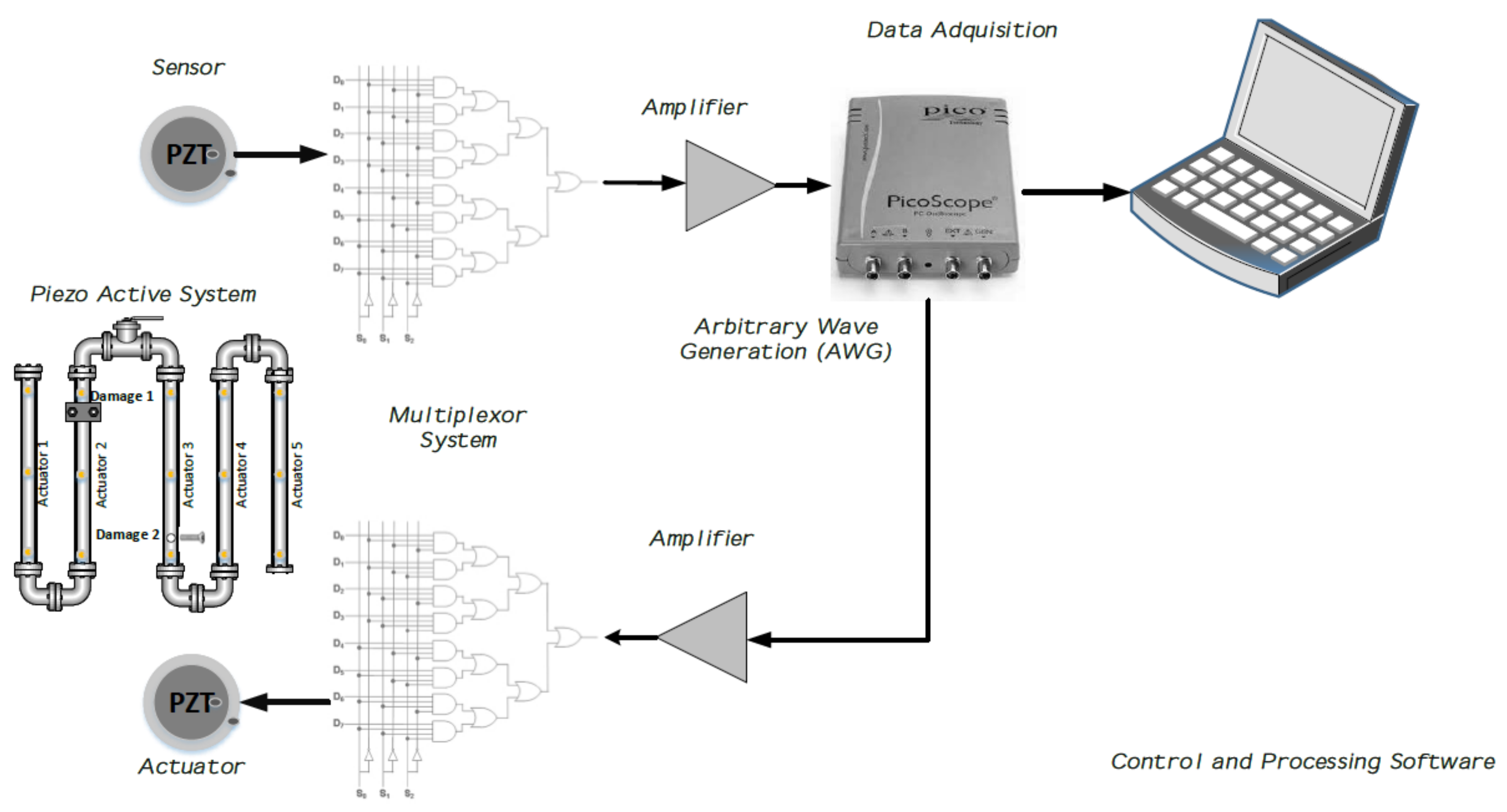
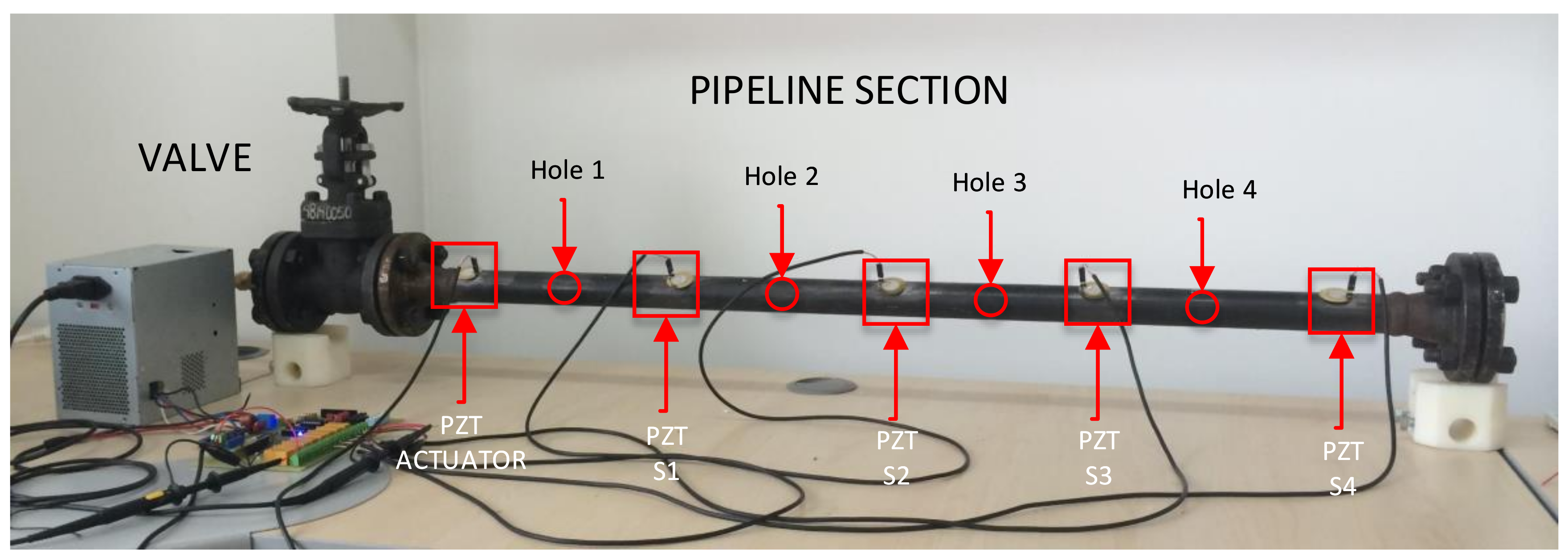

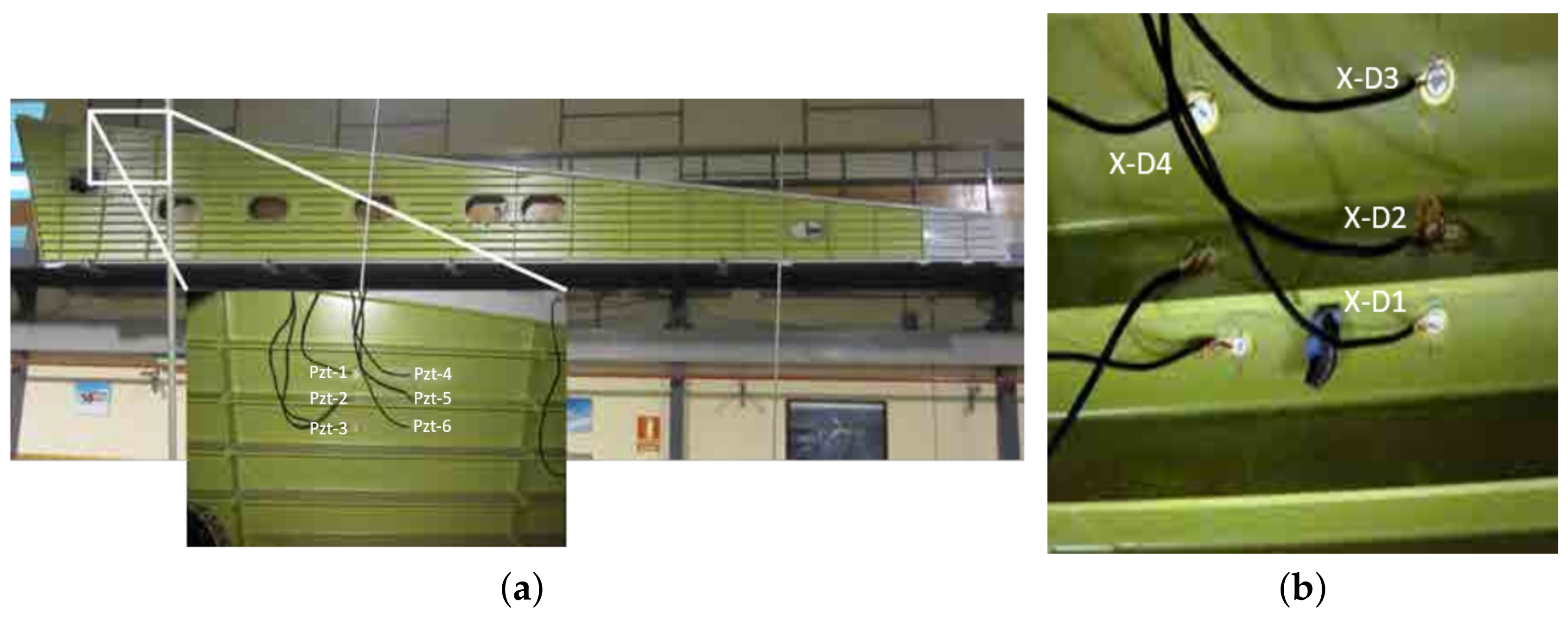
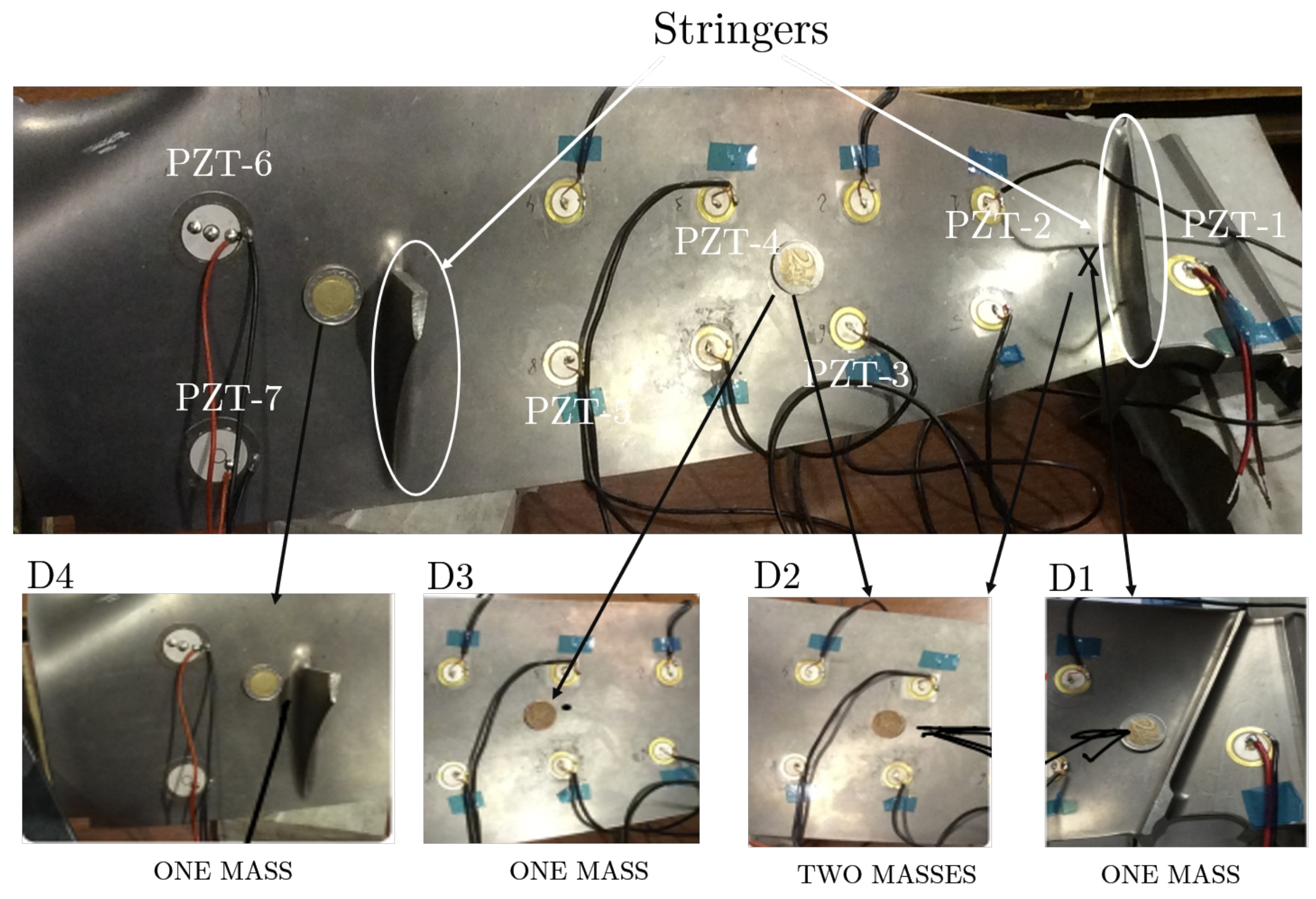
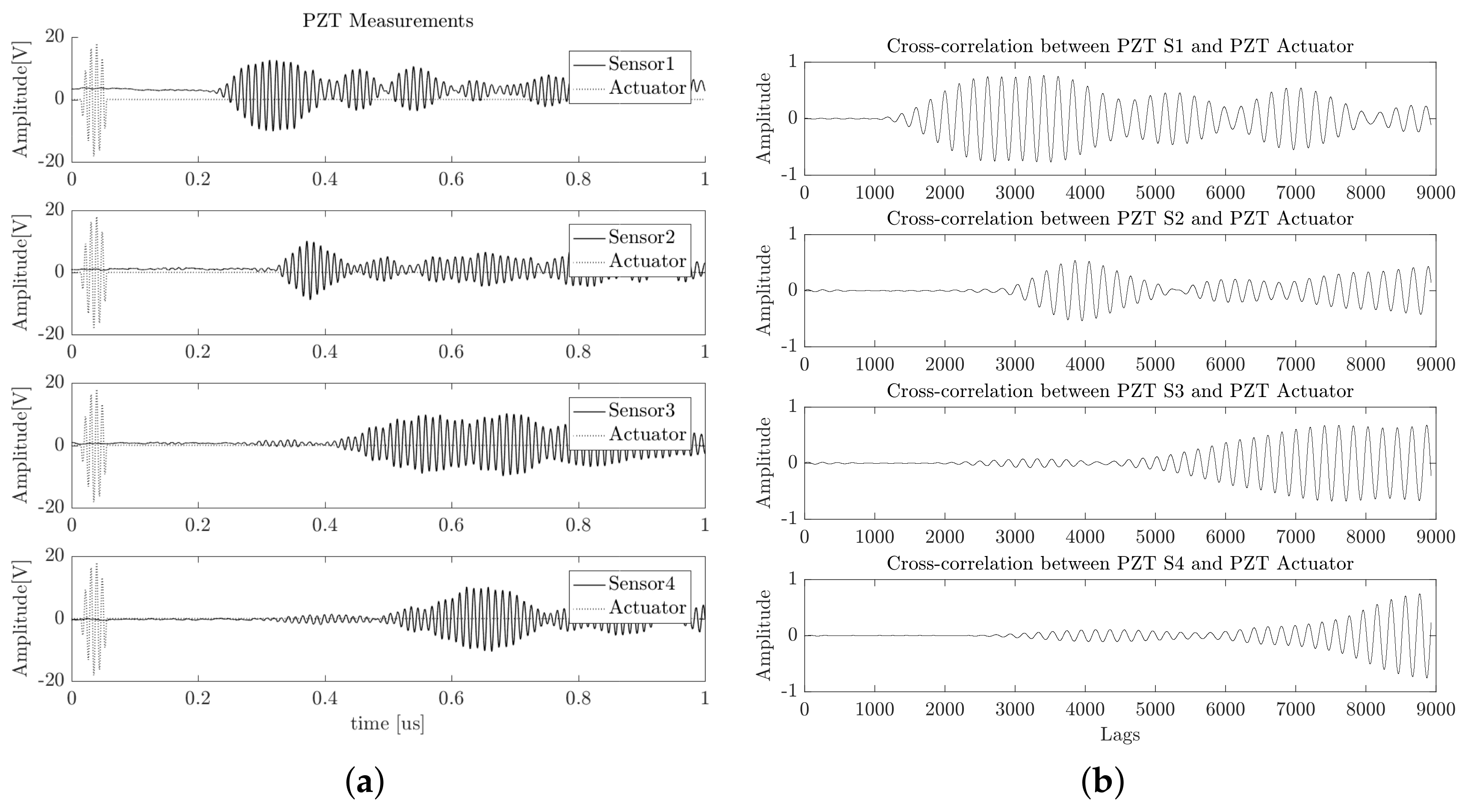

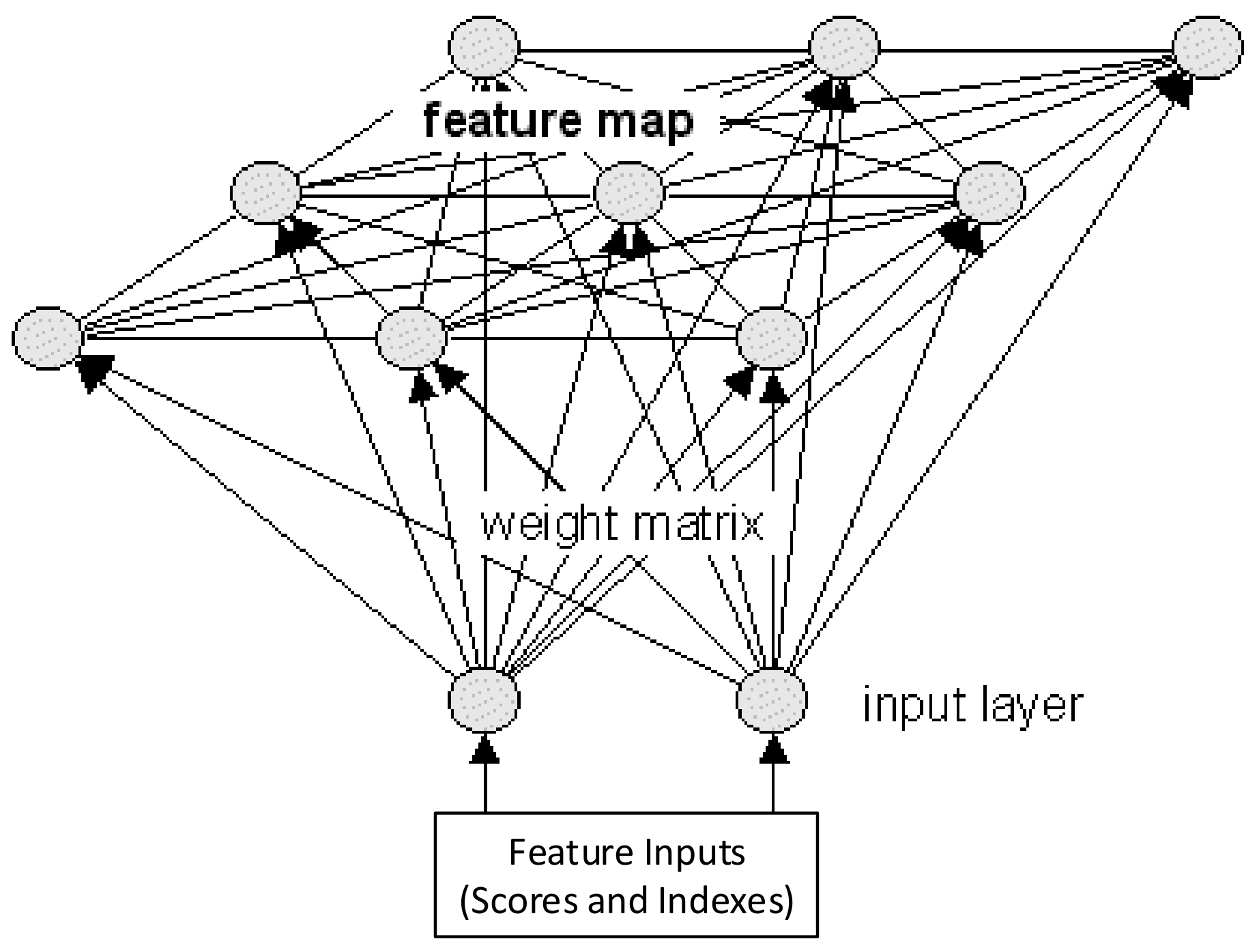


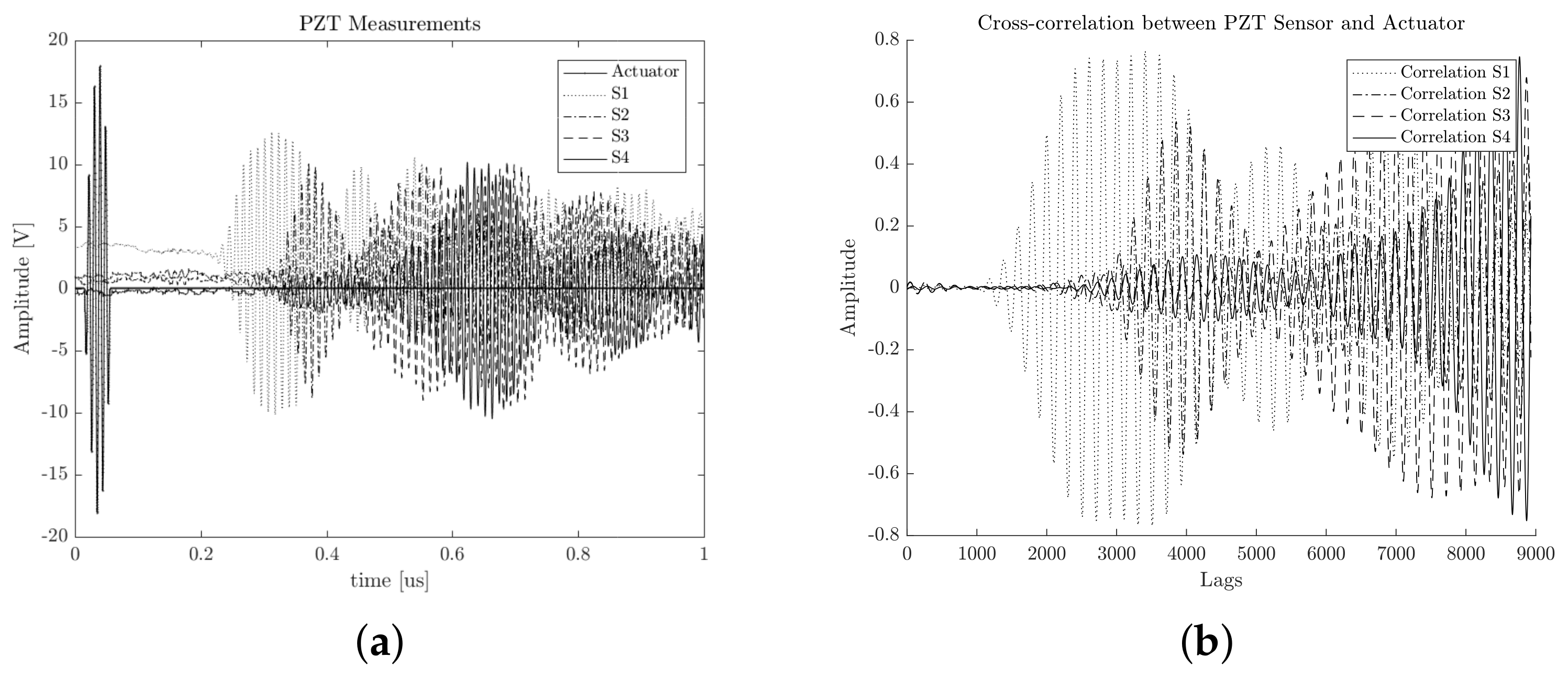

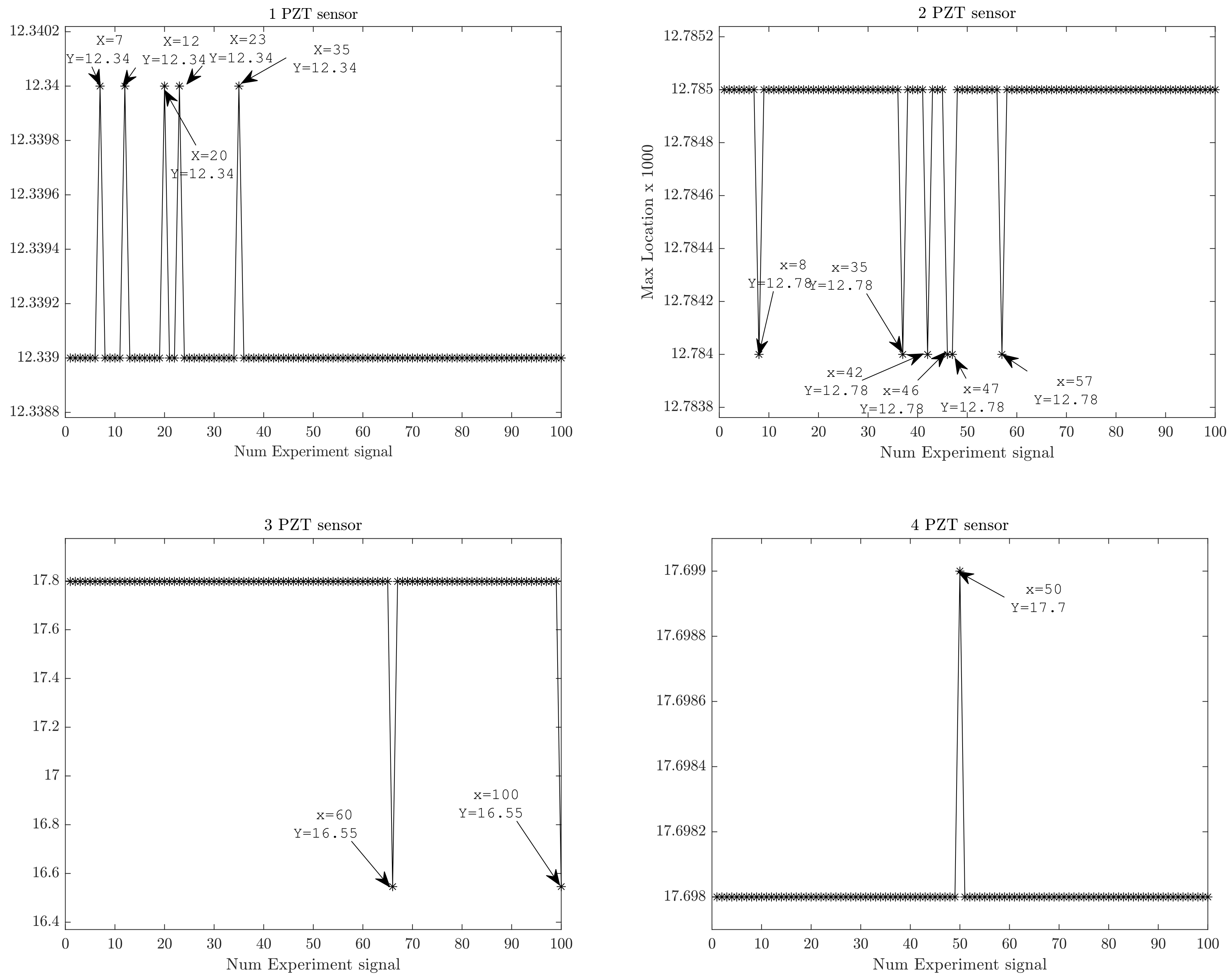
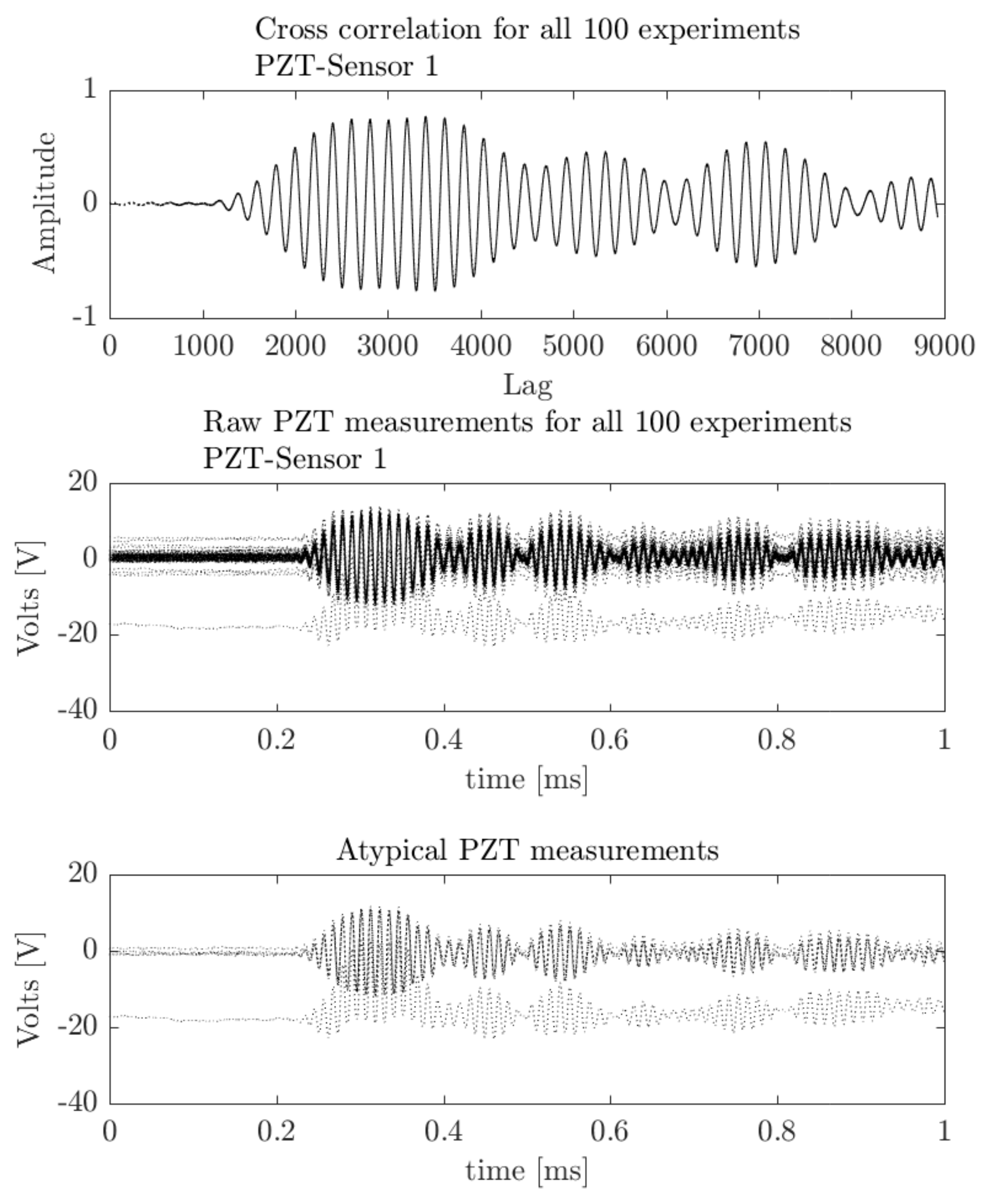
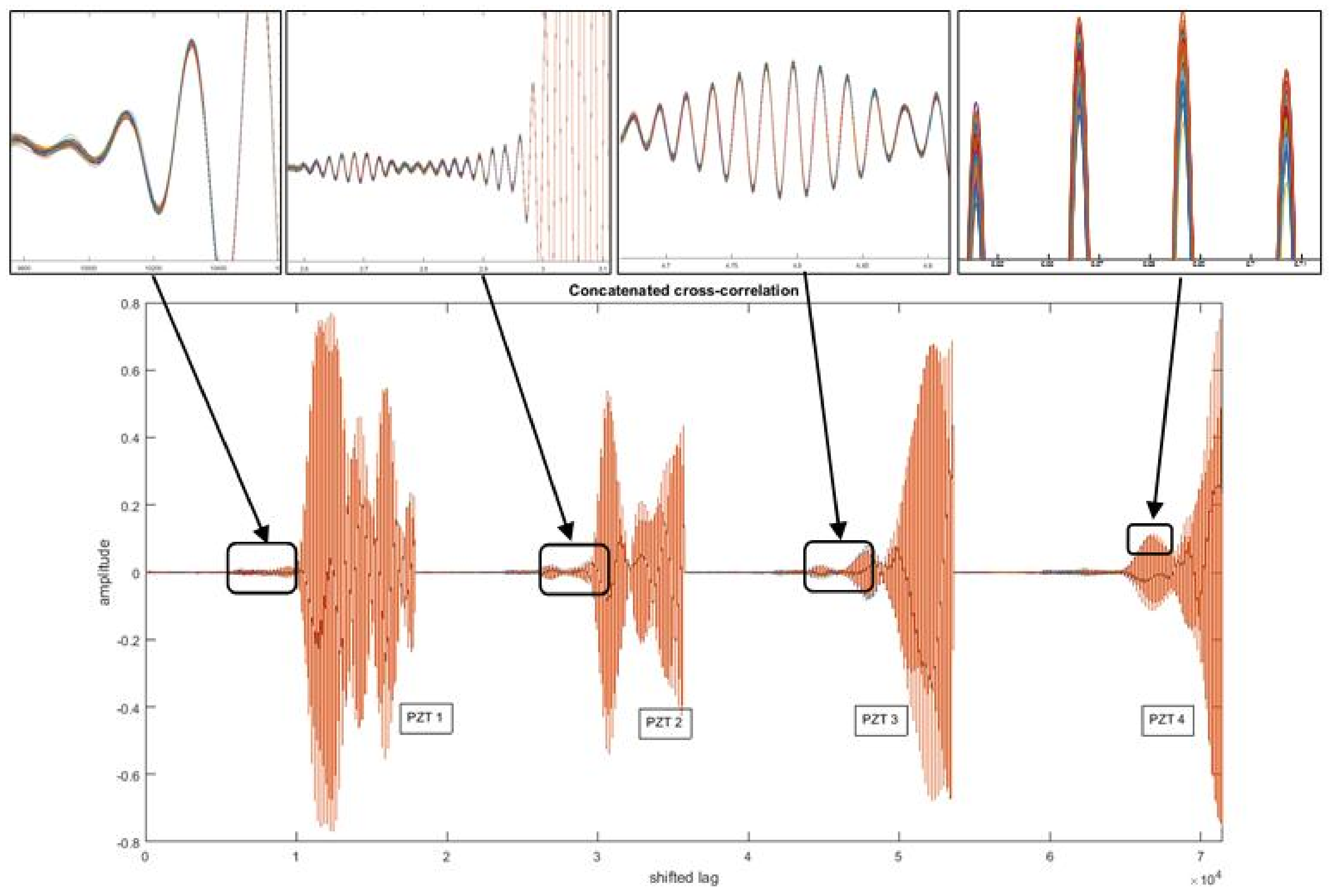
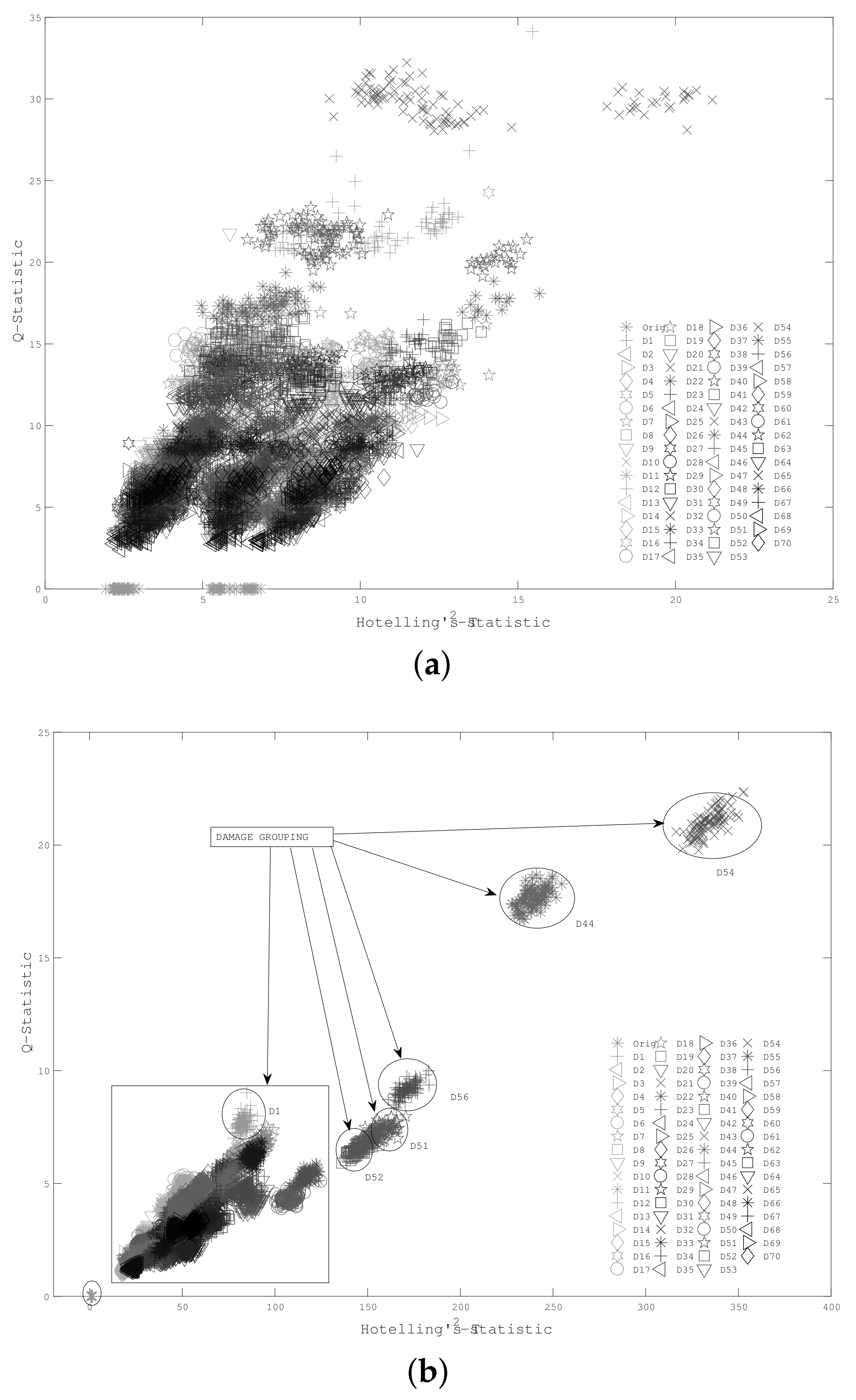
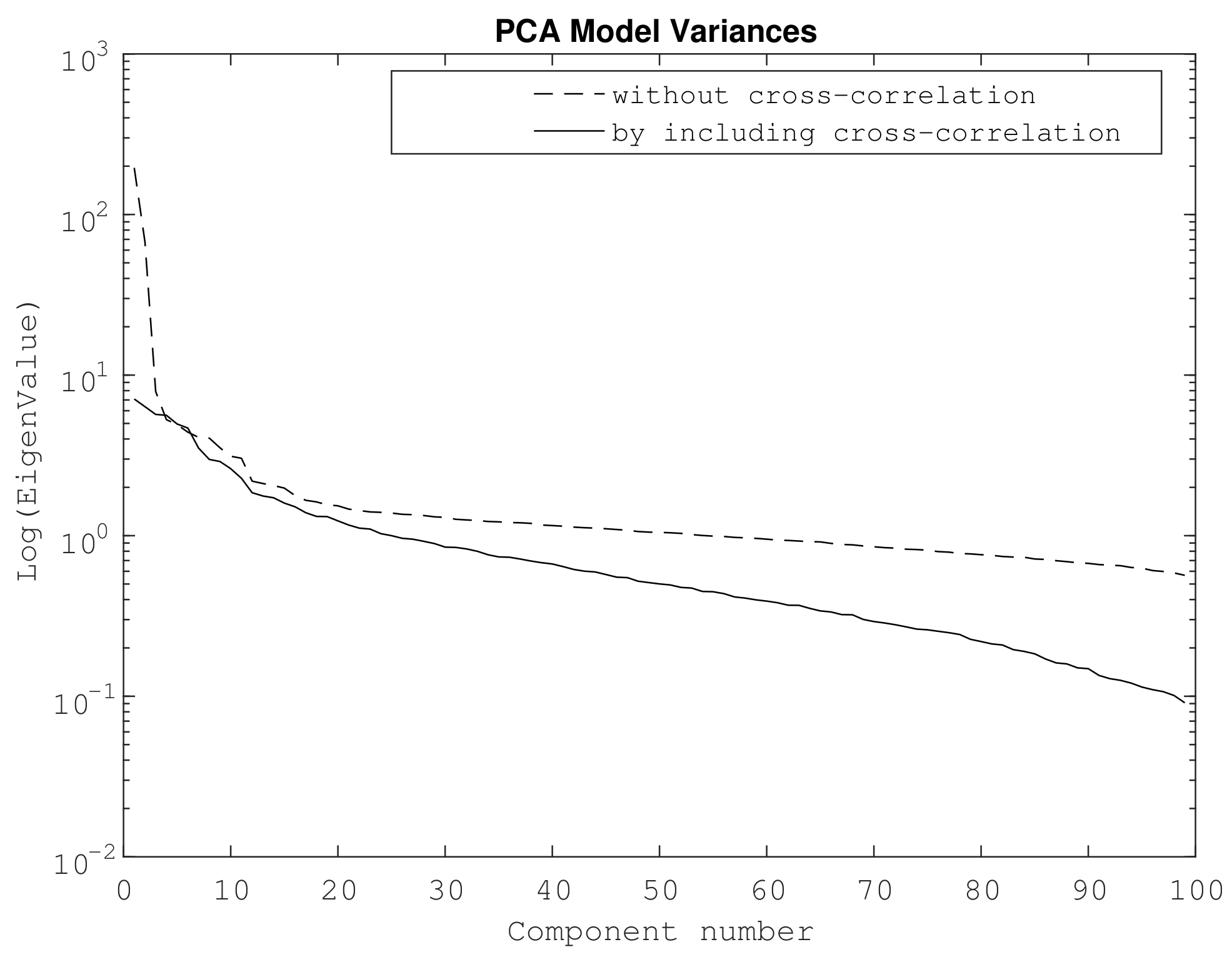

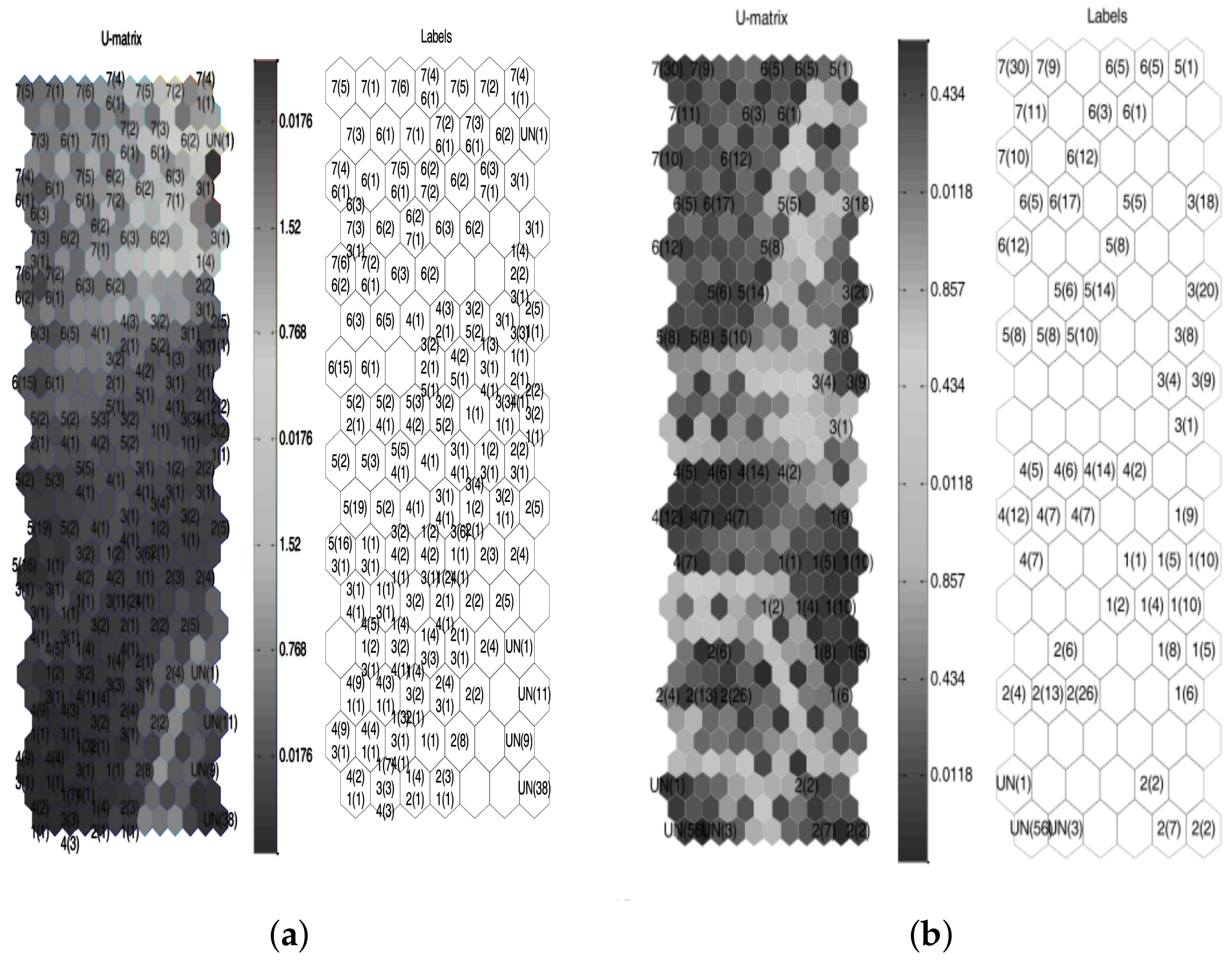
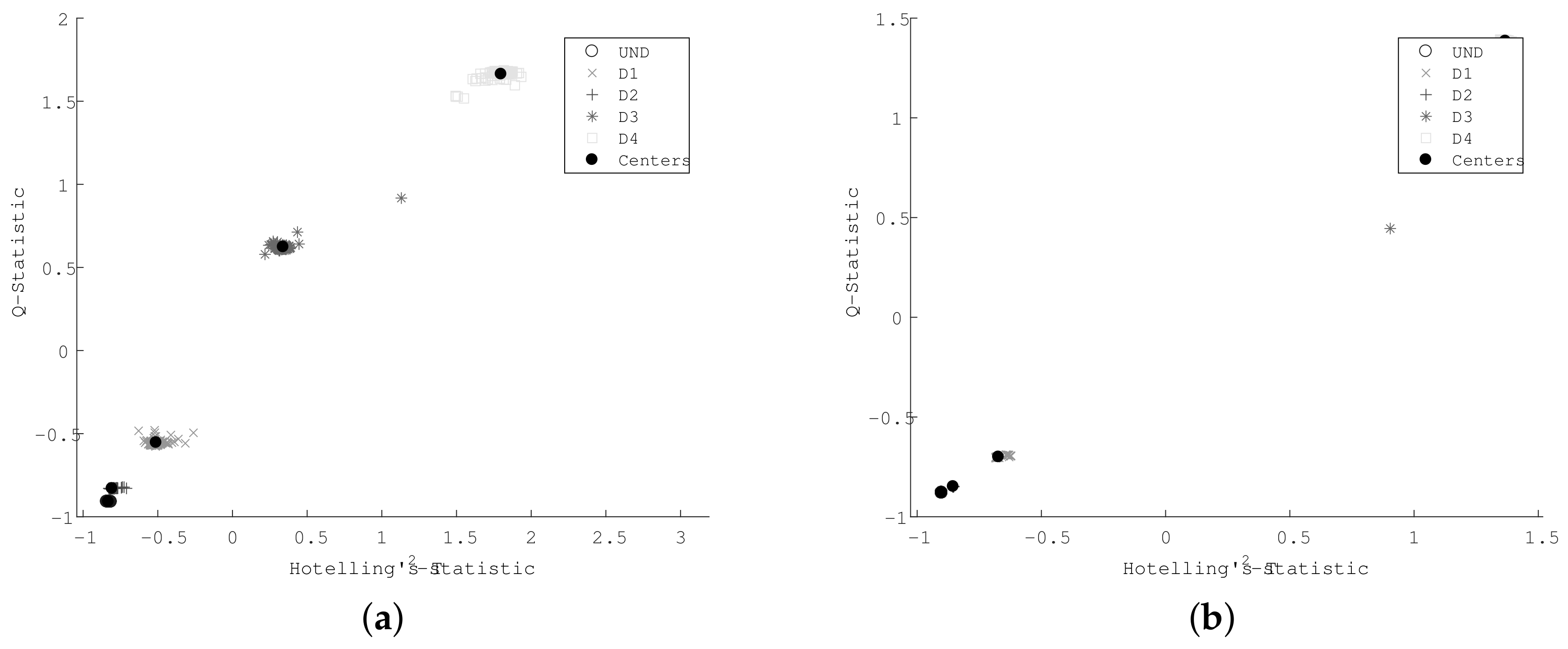

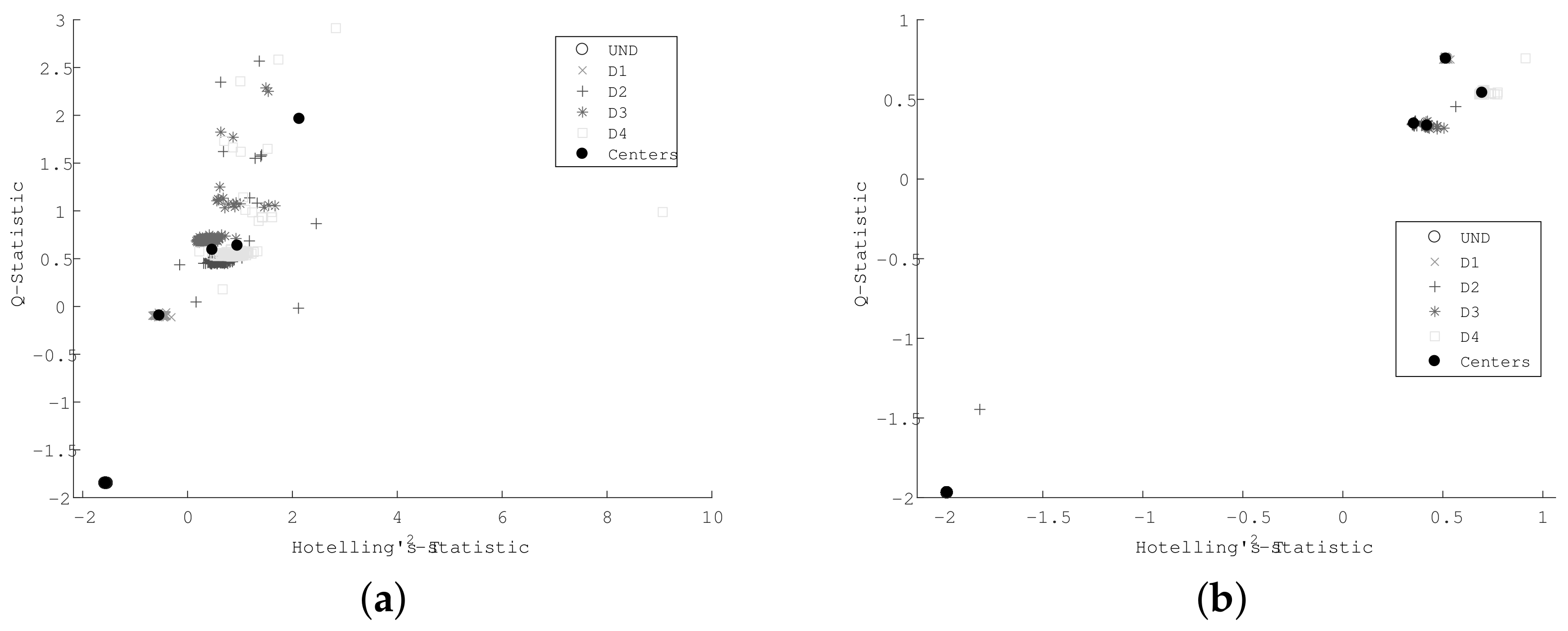

| Label | Leaks (Bold = Open) | Label | Leaks (Bold = Open) |
|---|---|---|---|
| D1 | H1, H2, H3, H4 | D5 | H1, H2, H3, H4 |
| D2 | H1, H2, H3, H4 | D6 | H1, H2, H3, H2 |
| D3 | H1, H2, H3, H4 | D7 | H1, H2, H3, H4 |
| D4 | H1, H2, H3, H4 | *H | denotes hole |
| Index | Uncorrelated Signals | Cross-Correlated Signals |
|---|---|---|
| Quantization error | 0.0186 | 0.0025 |
| Topographical error | 0.0686 | 0.2381 |
| Distortion measure | 0.7840 | 0.2734 |
| Training Error | 0.5714 | 0 |
| Empty Clusters | 42 | 63 |
| Validation Error | 2.6667 | 1.3333 |
| Index | Uncorrelated Signals | Cross-Correlated Signals |
|---|---|---|
| Quantization error | 0.0238 | 0.0021 |
| Topographical error | 0.3320 | 0.0362 |
| Distortion measure | 0.7840 | 0.1053 |
| Training Error | 6.2857 | 0 |
| Empty Clusters | 27 | 46 |
| Validation Error | 15.5556 | 1.3333 |
© 2018 by the authors. Licensee MDPI, Basel, Switzerland. This article is an open access article distributed under the terms and conditions of the Creative Commons Attribution (CC BY) license (http://creativecommons.org/licenses/by/4.0/).
Share and Cite
Camacho Navarro, J.; Ruiz, M.; Villamizar, R.; Mujica, L.; Quiroga, J. Features of Cross-Correlation Analysis in a Data-Driven Approach for Structural Damage Assessment. Sensors 2018, 18, 1571. https://doi.org/10.3390/s18051571
Camacho Navarro J, Ruiz M, Villamizar R, Mujica L, Quiroga J. Features of Cross-Correlation Analysis in a Data-Driven Approach for Structural Damage Assessment. Sensors. 2018; 18(5):1571. https://doi.org/10.3390/s18051571
Chicago/Turabian StyleCamacho Navarro, Jhonatan, Magda Ruiz, Rodolfo Villamizar, Luis Mujica, and Jabid Quiroga. 2018. "Features of Cross-Correlation Analysis in a Data-Driven Approach for Structural Damage Assessment" Sensors 18, no. 5: 1571. https://doi.org/10.3390/s18051571
APA StyleCamacho Navarro, J., Ruiz, M., Villamizar, R., Mujica, L., & Quiroga, J. (2018). Features of Cross-Correlation Analysis in a Data-Driven Approach for Structural Damage Assessment. Sensors, 18(5), 1571. https://doi.org/10.3390/s18051571





